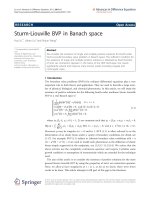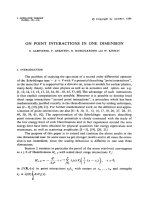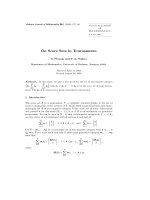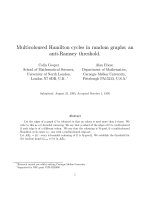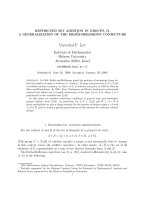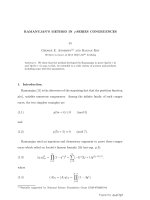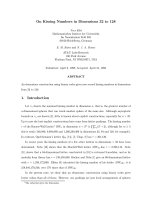Báo cáo toán học: "Longest increasing subsequences in pattern-restricted permutations" pptx
Bạn đang xem bản rút gọn của tài liệu. Xem và tải ngay bản đầy đủ của tài liệu tại đây (95.99 KB, 8 trang )
Longest increasing subsequences
in pattern-restricted permutations
Emeric Deutsch
Polytechnic University
Brooklyn, NY 11201
A. J. Hildebrand
University of Illinois
Urbana, IL 61801
Herbert S. Wilf
University of Pennsylvania
Philadelphia, PA 19104-6395
Submitted: Apr 8, 2003; Accepted: Apr 21, 2003; Published: May 3, 2003
MR Subject Classifications: 05A16, 05A05
Abstract
Inspired by the results of Baik, Deift and Johansson on the limiting distribution
of the lengths of the longest increasing subsequences in random permutations, we
find those limiting distributions for pattern-restricted permutations in which the
pattern is any one of the six patterns of length 3. We show that the (132)-avoiding
case is identical to the distribution of heights of ordered trees, and that the (321)-
avoiding case has interesting connections with a well known theorem of Erd˝os-
Szekeres.
1 Introduction
A great deal of spectacular work has been done on determining the distribution of the
length of the longest increasing subsequence, LIS(p), in a random permutation p.This
work culminated in the paper of Baik, Deift and Johansson [2] which found the limiting
distribution function.
Historically, the average length, µ(n), of the LIS had been found to be ≥
√
n/2[6]
and then ≥ 2
√
n [12]. The correct order of magnitude was established in [18], where it
was shown to be ∼ 2
√
n. Next the standard deviation σ(n) had been estimated [13] to
be approximately n
1/6
but was not proved to be so. Finally, in [2], the complete limiting
distribution function of the normalized random variable (LIS−µ(n))/n
1/6
was determined.
We can ask the same questions in some given subset of the set of all permutations.
For example, what is the distribution of the length of the longest increasing subsequence
in a randomly chosen permutation from the set of those that avoid the pattern
1
(231),
1
A permutation p avoids (132) (resp. (231), (321)) if there do not exist 1 ≤ i<j<k≤ n s.t.
p(i) <p(k) <p(j)(resp.p(k) <p(i) <p(j), p(i) >p(j) >p(k)).
the electronic journal of combinatorics 9(2) (2003), #R12 1
or the pattern (321)? The tools are available for the study of such problems. A paper of
Reifegerste [14] finds a simple expression for the frequencies of different LIS lengths in the
(231)-avoiding case. For (132)-avoiding permutations it turns out that the distributions
are identical with known distribution functions of ordered trees by height, so we can
simply quote the known results. Finally, for (321)-avoiding permutations the problem is
related to a celebrated theorem of Erd˝os-Szekeres. In this case we exhibit the relevant
statistics and find explicitly the limiting distribution function.
We remark that for all six of the patterns of length 3 it is true that the number of
permutations of n letters that avoid the pattern is the Catalan number C
n
=
2n
n
/(n+1).
So for each of the six patterns that we will study here, we will be asking what fraction
of the roughly c4
n
/n
3/2
permutations that avoid that pattern have a LIS of some given
length.
Our main results are the following.
Theorem 1. In the class of (231)-avoiding permutations of n letters, and in the class of
(312)-avoiding permutations of n letters, the length of the longest increasing subsequence
has mean (n +1)/2, and standard deviation ∼
√
n/2. Moreover, the random variable
(LIS(p) −(n +1)/2)/(
√
n/2) has asymptotically the standard normal distribution.
Theorem 2. In the class of (132)-avoiding permutations of n letters, and in the class of
(213)-avoiding permutations of n letters, the length of the longest increasing subsequence
has mean =
√
πn + O(n
1
4
) and standard deviation
= c
1
√
n + O(n
1
4
)
c
1
=
π
π
3
− 1
=0.38506
. (1.1)
Moreover, the normalized random variable
X
n
(p)=
def
LIS(p) −
√
πn
√
n
,
defined for n-permutations p that avoid the pattern (132), satisfies
lim
n→∞
Prob(X
n
(p) ≤ θ)=
∞
t=−∞
(1 − 2t
2
(θ +
√
π)
2
)e
−(θ+
√
π)
2
t
2
(θ>−
√
π). (1.2)
Theorem 3. For permutations p in the class of (321)-avoiding permutations of n letters,
define the random variable
X
n
(p)=
def
LIS(p) −
n
2
√
n
.
Then we have
lim
n→∞
Prob(X
n
(p) ≤ θ)=
2
√
π
4θ
2
0
u
1/2
e
−u
du
=
Γ(3/2, 4θ
2
)
Γ(3/2)
,
the electronic journal of combinatorics 9(2) (2003), #R12 2
where Γ(z, w) is the incomplete Gamma function
Γ(z, w)=
w
0
u
z−1
e
−u
du.
2 Avoiding the pattern (231)
One situation where it is simple to deduce the limiting distribution is that of (231)-
avoiding permutations. This is because Reifegerste [14] has shown that the number of
(231)-avoiding permutations whose longest increasing subsequence has length exactly k is
e(n, k)=
1
n
n
k
n
k − 1
. (2.1)
The number of all (231)-avoiding permutations of n letters is C
n
, the Catalan number.
From this it is easy to check that the mean length of the LIS in this family is (n +1)/2
and the standard deviation is
√
n/2+O(1). Finally it is a straightforward exercise in
Stirling’s formula to find that
lim
n→∞
√
n
e
n,
n+1
2
+ θ
√
n
2
C
n
=
2
√
π
e
−θ
2
.
This says that for (231)-avoiding permutations p, the random variable
X(p)=
LIS(p) −
n+1
2
1
2
√
n
has asymptotically the standard normal distribution.
It seems noteworthy that in this case the mean is quite large, i.e., typically such a
permutation contains an increasing subsequence whose length is about half that of the
permutation itself.
It also is noteworthy that (2.1) shows that the number of (231)-avoiding permutations
of n letters whose longest increasing subsequence has length k is the same as the number
whose longest increasing subsequence has length n−k +1. Itisarrestingthatthenumber
of (231)-avoiding permutations of, say, 1000 letters, whose LIS has length 980 is equal to
the number whose LIS has length 21.
3 Avoiding the pattern (132)
The case of (132)-avoiding permutations is handled by the following sequence of observa-
tions.
• The number f(n, k)ofn-permutations that avoid (132) and whose longest increasing
subsequence has length <kis equal to the number of ordered trees of n edges whose
height is <k. This follows from a bijection of Jani and Rieper [10].
the electronic journal of combinatorics 9(2) (2003), #R12 3
• It is known from the theory of ordered trees [5] that this number is
f(n, k)=2
∞
t=−∞
2n
n + t(k +1)
−
1
4
2n +2
n +1+t(k +1)
(k =1, 2, 3, ).
(3.1)
• To see that the normalized random variable
X(p
n
)=
LIS(p
n
) −
√
πn
√
n
,
defined on (132)-avoiding permutations p
n
of n letters, has a nontrivial limiting
distribution, as n →∞,weconsider
Prob(X(p
n
) <θ) = Prob(LIS(p
n
) ≤ (θ +
√
π )
√
n)
=
f(n,
√
n(θ +
√
π ))
C
n
,
where
C
n
=
1
n +1
2n
n
is the nth Catalan number. But by (3.1) we see that
f(n,
√
n(θ +
√
π )) =
1
C
n
∞
t=−∞
φ(n, t),
in which the general t-th term of the sum is
φ(n, t)=
n +1
2n
n
2n
n + tc
√
n
2 −
(n + 1)(2n +1)
(n +1)
2
− t
2
c
2
n
. (c = θ +
√
π)
It is an easy exercise in Stirling’s formula to see that
lim
n→∞
φ(n, t)=(1−2c
2
t
2
)e
−c
2
t
2
and the proof is complete.
The limiting cumulative distribution function F (θ), in (1.2), is related to the Jacobi
theta function
Θ(x)=
∞
t=−∞
e
−t
2
πx
.
In fact, F (θ)=Θ(u)+2uΘ
(u), where u =(1+θ/
√
π)
2
. It is well known [8] that this
is indeed the limiting distribution, from the theory of ordered trees, but the derivation is
simple enough that we have included it above. Indeed [8] shows that this same distribution
the electronic journal of combinatorics 9(2) (2003), #R12 4
function, originally considered by R´enyi and Szekeres [15], is the limiting distribution
function for many classes of trees.
We remark that although the Jani-Rieper bijection [10] is the most explicit mapping
between 132-avoiding permutations of n letters whose LIS has length k and ordered trees
of n edges whose height is k, there are other, somewhat less explicit, bijections in the
literature. Indeed, in Krattenthaler [11], we find an explicit bijection between such per-
mutations and Dyck paths. This mapping has the property that the length of the LIS
corresponds to the height of the image path. In view of well known bijections between
Dyck paths by height and ordered trees by height, we have, by composition, the mapping
that we need here. Likewise in Chow, West [4] there are remarks in section 5 that suggest,
less explicitly, that such bijections exist. Other, equivalent bijections with Dyck paths
have been given by Fulmek [9], Reifegerste [14], and Bandlow and Killpatrick [3].
4The(321) case and the Erd˝os-Szekeres theorem
Finally we ask for the limiting distribution function for the length of the longest increasing
subsequence in the class S
n
(321) of (321)-avoiding permutations of n letters. Let f(n, k)
denote the number of such permutations whose longest increasing subsequence has length
≤ k. A famous theorem of Erd˝os-Szekeres states that every permutation of (r−1)(s−1)+1
or more letters contains either a decreasing subsequence of length r or an increasing
subsequence of length s.Ifwetaker = 3 we see that every permutation in the class
S
2k+1
(321) has an increasing subsequence of length k+1, i.e. f(n, k) = 0 for all n ≥ 2k+1.
Even though, for each fixed k, f(n, k) vanishes for all large enough n, the question of
the limiting distribution function of the LIS remains.
Theorem 4. The number a(n, k) of (321)-avoiding permutations having longest increasing
subsequence of length = k is given by
a(n, k)=
2k −n +1
n +1
n +1
k +1
2
(4.1)
for (n +1)/2≤k ≤ n, and vanishes otherwise.
These permutations correspond 1-1, under the Schensted insertion algorithm (see, e.g.,
[16]), to pairs of Young tableaux with n cells,atmosttworows,andk columns, so the
number of them is B
2
,whereB is the number of such tableaux. A brief computation
with the hook formula shows that
B =
2k − n +1
n +1
n +1
n −k
,
completing the proof. ✷
It follows that the number f(n, k) of permutations in S
n
(321) whose LIS has length
≤ k is
f(n, k)=
(n+1)/2≤j≤k
2j − n +1
n +1
n +1
j +1
2
. (4.2)
the electronic journal of combinatorics 9(2) (2003), #R12 5
Now fix t>0. The probability that a permutation of n letters has LIS of length at most
n/2+t
√
n is
f(n, n/2+t
√
n)
1
n+1
2n
n
.
Hence the limiting probability distribution function that we seek is
F (t) = lim
n→∞
1
1
n+1
2n
n
(n+1)/2≤j≤n/2+t
√
n
2j − n +1
n +1
n +1
j +1
2
= lim
n→∞
4
(n +1)
2n
n
0≤k≤t
√
n+1/2
k
2
n +1
(n +1)/2+k
2
.
By an easy application of Stirling’s formula the relation
2m
m−k
2m
m
∼ e
−k
2
/m
holds uniformly for all |k| <t
√
m, and we have
F (t)=
32
√
π
lim
n→∞
1
√
n
0≤k≤t
√
n
k
2
n
e
−4k
2
/n
.
The quantity whose limit is being taken is a Riemann sum that approximates the integral
t
0
x
2
e
−4x
2
with grid size 1/
√
n, and so the desired limit is
F (t)=
32
√
π
t
0
x
2
e
−4x
2
dx
=
2
√
π
4t
2
0
u
1/2
e
−u
du
=
Γ(3/2, 4t
2
)
Γ(3/2)
.
The limiting distribution F (t) is well-known in statistics: Except for a linear change of
variables, it is a χ
2
distribution with three degrees of freedom, which arises as the distri-
bution of the length of a 3-vector whose entries are independent standard normal random
variables (see, for example, [1]). It would be interesting to find a heuristic explaining this
connection.
the electronic journal of combinatorics 9(2) (2003), #R12 6
5 Other patterns of three letters
We have so far dealt with the statistics of the length of the longest increasing subsequence
in permutations that avoid any one of the patterns (132), (231), or (321). There remain
three other patterns of three letters, viz. (123), (312), and (213).
The (123) case is trivial. If an n-permutation avoids (123) then its LIS has length
exactly 2 except for the reversal of the identity permutation, whose LIS has length 1.
The (312) case is identical with the (231). Indeed, the length of the LIS of a (312)-
avoiding permutation is equal to the length of the longest decreasing subsequence of
its reversal, which is (213)-avoiding, and that is equal to the length of the LIS of the
complement of its reversal, which is (231)-avoiding, as claimed.
Similarly, by reversal and complementation, the (213) case is identical with the (132).
We thank Christian Krattenthaler, Brendan McKay and Julian West for informative
discussions related to this paper.
References
[1] M. Abramowitz and I. Stegun, Handbook of Mathematical Functions, Dover Publ.,
New York, 1965.
[2] J. Baik, P. Deift and K. Johansson, On the distribution of the length of the longest
increasing subsequence of random permutations, J. Amer. Math. Soc. 12 (1999)
1119-1178.
[3] Jason Bandlow and Kendra Killpatrick, An Area-to-Inv Bijection Between Dyck
Paths and 312-avoiding Permutations, Elec. J. Combinatorics 8 (2001), #R40.
[4] T. Chow and J. West, Forbidden subsequences and Chebyshev polynomials, Discr.
Math. 204 (1999), 119–128.
[5] De Bruijn, N.G., Knuth, D.E., and Rice, S.O., The average height of planted plane
trees, In Graph Theory and Computing (1972), R.C. Read, Ed., Academic Press,
15–22.
[6] P. Erd˝os and G. Szekeres, A combinatorial theorem in geometry, Compositio Math.,
2 463-470, (1935).
[7] Philippe Flajolet, Xavier Gourdon and Philippe Dumas, Mellin transforms and
asymptotics: harmonic sums, 55 pp., see, e.g.,the website of Flajolet.
[8] Philippe Flajolet and Andrew Odlyzko, The average height of binary trees and other
simple trees, J. Computer and System Sciences 25 (1982), 171–213.
the electronic journal of combinatorics 9(2) (2003), #R12 7
[9] Markus Fulmek, Enumeration of permutations containing a prescribed number of
occurrences of a pattern of length three, arXiv: math.CO/0112092, Apr. 2002.
[10] Mahendra Jani and Robert Rieper, Continued fractions and Catalan problems, Elec-
tronic J. Combinatorics 7 (2000), #R45.
[11] C. Krattenthaler, Permutations with restricted patterns and Dyck paths, Adv. Appl.
Math. 27 (2001), 510-530.
[12] B.F.Logan and L.A.Shepp, A variational problem for random Young tableaux, Ad-
vances in Math., 26, 206-222, (1977).
[13] A.M.Odlyzko and E.M.Rains, On longest increasing subsequences in random per-
mutations, Analysis, geometry, number theory: the mathematics of Leon Ehrenpreis
(Philadelphia, PA, 1998), 439–451, Contemp. Math., 251, Amer. Math. Soc., Prov-
idence, RI, 2000.
[14] Astrid Reifegerste, On the diagram of 132-avoiding permutations, arXiv: math.
CO/ 0208006, Aug. 2002.
[15] A. R´enyi and G. Szekeres, On the height of trees, J. Austral. Math. Soc. 7 (1967),
497–507.
[16] B. E. Sagan, The Symmetric Group, 2nd edition, Springer, New York, 2001.
[17] C. Schensted, Longest increasing and decreasing subsequences, Canad. J. Math.,
13, 1961, 179-191.
[18] A.M.Vershik and S.V.Kerov, Asymptotics of the Plancherel measure of the symmet-
ric group and the limiting form of Young tables, Soviet Math. Dokl., 18, 527-531,
(1977).
the electronic journal of combinatorics 9(2) (2003), #R12 8
